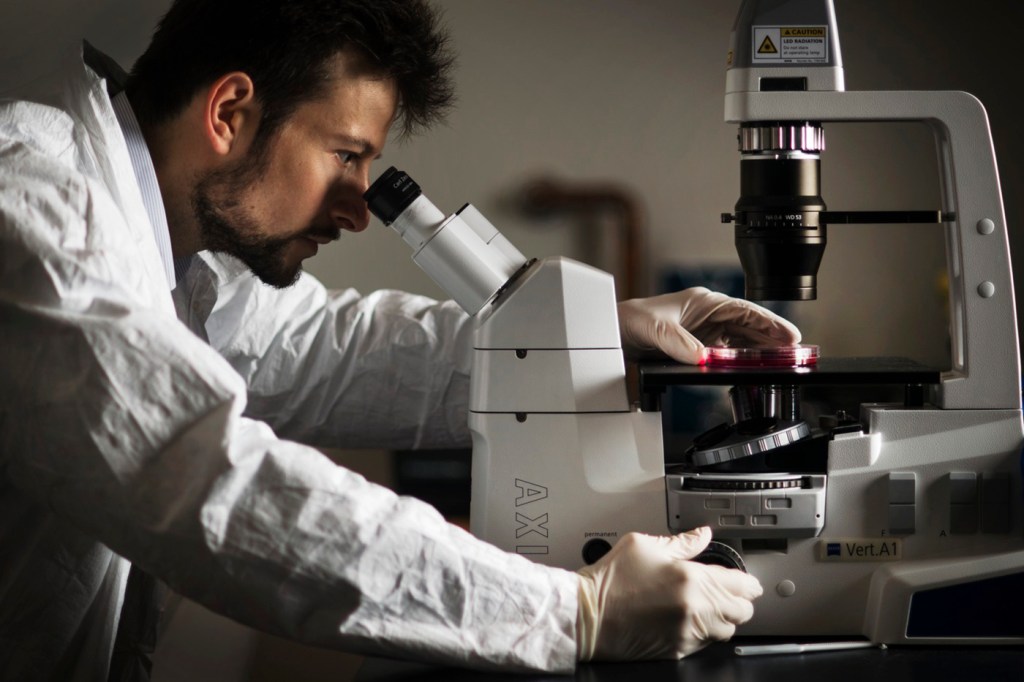Research suggests new direction for tissue engineering and cancer therapeutics

Nikolai Slavov, a new assistant professor in the Department of Bioengineering, wasn’t looking to upend conventional wisdom when he set out to measure protein levels in ribosomes, the particles in cells that synthesize all the other proteins that keep living things—from animals to bacteria—functioning. He just wanted to understand what was driving some of the yeast cells in his lab to grow faster than others.
Now, in a new paper published Thursday in the journal Cell Reports, Slavov and his colleagues have cast ribosomes in a new light—research that could have implications for new directions in fields from tissue engineering to cancer therapeutics.
Slavov’s findings indicate that ribosomes not only assemble proteins by linking together the specific chemical groups, or “amino acids,” that make up each protein; they also appear to regulate that production. In a sense, a biological construction worker has now become a general contractor. Ribosomes may determine, for example, how many of which types of protein roll off the assembly line.
“What I have found suggests that ribosomes are likely to be among the primary factors in not just synthesizing proteins but determining which protein molecules are made in which tissue type,” says Slavov. “In tissue engineering, if we want to reprogram, say, an embryonic stem cell to make a heart cell, we know now that we may have to take into account how to influence the ribosome.”
The building blocks of life
Proteins are, essentially, the building blocks of life. They are large, complex molecules made up of varying chains of amino acids, and they serve a multitude of functions: as structural materials (bones, muscles, hair), enzymes (proteins that spark biological reactions), and messengers (some hormones).
Certain core proteins reside inside each ribosome—they are what enable the ribosome to do its protein-assembly job. For decades scientists believed that all ribosomes had the same composition, that is, they all contained 80 core proteins: You’d seen the composition of one ribosome, you’d seen them all.
But in his new study, Slavov revealed that may not be the case. Using the most up-to-date techniques of mass spectrometry, he painstakingly measured the ribosome proteins in samples of yeast cells and mouse embryonic stem cells—the disparate cell types would permit him to generalize his results.
Ribosomes, his data indicated, are not all cut from the same cloth: their composition, and hence their function, varies.
If it is causal…it will open the pathway to new cancer therapies that are directed toward ribosomes specifically
—Slavov said
From passive to active role
Ribosomes get their protein-assembly instructions—which amino acids to link in a chain and in what order they should link—from a molecule called messenger RNA, or mRNA. Think of mRNA as DNA’s Uber service: mRNA picks up instructions from genes and carries them to the ribosomes, which then assemble the proteins.
Until now, says Slavov, scientists believed that ribosomes in unperturbed cells had a passive role in the expression of genetic information. That is, in the ribosome, the core proteins simply followed the mRNA instructions; they did not determine how often those instructions were translated and, in turn, how many molecules of that particular protein were produced.
Everything changes, however, if the composition of the core proteins varies. For example, certain cancers, such as uterine cancer, are associated with mutations in genes that code for a particular core protein, perhaps affecting that protein’s proper function. The altered composition of the proteins, says Slavov, might boost the ribosome’s capacity for protein synthesis and therefore promote cancer cell growth.
“This is not proven yet,” he cautions. The next step is to test the hypothesis further to show that there’s an actual cause-and-effect relationship between the core protein function and cancer cell growth. “If it is causal,” he says, “it will open the pathway to new cancer therapies that are directed toward ribosomes specifically.”
The other contributors to the research are from Harvard University, Leiden University, and the University Medical Center Utrecht.





